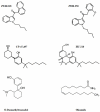Beyond THC: The New Generation of Cannabinoid Designer Drugs - PubMed (original) (raw)
Beyond THC: The New Generation of Cannabinoid Designer Drugs
Liana Fattore et al. Front Behav Neurosci. 2011.
Abstract
Synthetic cannabinoids are functionally similar to delta9-tetrahydrocannabinol (THC), the psychoactive principle of cannabis, and bind to the same cannabinoid receptors in the brain and peripheral organs. From 2008, synthetic cannabinoids were detected in herbal smoking mixtures sold on websites and in "head shops" under the brand name of Spice Gold, Yucatan Fire, Aroma, and others. Although these products (also known as "Spice drugs" or "legal highs") do not contain tobacco or cannabis, when smoked they produce effects similar to THC. Intoxication, withdrawal, psychosis, and death have been recently reported after consumption, posing difficult social, political, and health challenges. More than 140 different Spice products have been identified to date. The ability to induce strong cannabis-like psychoactive effects, along with the fact that they are readily available on the Internet, still legal in many countries, marketed as natural safe substances, and undetectable by conventional drug screening tests, has rendered these drugs very popular and particularly appealing to young and drug-naïve individuals seeking new experiences. An escalating number of compounds with cannabinoid receptor activity are currently being found as ingredients of Spice, of which almost nothing is known in terms of pharmacology, toxicology, and safety. Since legislation started to control the synthetic cannabinoids identified in these herbal mixtures, many new analogs have appeared on the market. New cannabimimetic compounds are likely to be synthesized in the near future to replace banned synthetic cannabinoids, leading to a "dog chasing its tail" situation. Spice smokers are exposed to drugs that are extremely variable in composition and potency, and are at risk of serious, if not lethal, outcomes. Social and health professionals should maintain a high degree of alertness for Spice use and its possible psychiatric effects in vulnerable people.
Keywords: Internet; addiction; cannabimimetics; designer drugs; herbal blends; natural highs; spice; synthetic cannabinoids.
Figures
Figure 1
Timeline of synthetic cannabinoids and Spice products.
Figure 2
Structures of most common psychoactive ingredients of Spice products: synthetic cannabinoids (JWH-018, JWH-250, CP-47,497, HU-210), μ-opioid agonists (_O_-Desmethyltramadol), and fatty acid derivatives with cannabinoid-like activity (Oleamide).
Similar articles
- [Spice drugs: cannabinoids as a new designer drugs].
Mustata C, Torrens M, Pardo R, Pérez C; Psychonaut Web Mapping Group; Farré M. Mustata C, et al. Adicciones. 2009;21(3):181-6. Adicciones. 2009. PMID: 19718488 Spanish. - [Spice in France: mixed herbs containing synthetic cannabinoids].
Schlatter J, Chiadmi F, Chariot P. Schlatter J, et al. Ann Biol Clin (Paris). 2012 Jul-Aug;70(4):413-22. doi: 10.1684/abc.2012.0728. Ann Biol Clin (Paris). 2012. PMID: 22796613 French. - Monitoring of herbal mixtures potentially containing synthetic cannabinoids as psychoactive compounds.
Dresen S, Ferreirós N, Pütz M, Westphal F, Zimmermann R, Auwärter V. Dresen S, et al. J Mass Spectrom. 2010 Oct;45(10):1186-94. doi: 10.1002/jms.1811. J Mass Spectrom. 2010. PMID: 20857386 - Synthetic cannabinoids: epidemiology, pharmacodynamics, and clinical implications.
Castaneto MS, Gorelick DA, Desrosiers NA, Hartman RL, Pirard S, Huestis MA. Castaneto MS, et al. Drug Alcohol Depend. 2014 Nov 1;144:12-41. doi: 10.1016/j.drugalcdep.2014.08.005. Epub 2014 Aug 18. Drug Alcohol Depend. 2014. PMID: 25220897 Free PMC article. Review. - The synthetic cannabinoids phenomenon: from structure to toxicological properties. A review.
Alves VL, Gonçalves JL, Aguiar J, Teixeira HM, Câmara JS. Alves VL, et al. Crit Rev Toxicol. 2020 May;50(5):359-382. doi: 10.1080/10408444.2020.1762539. Epub 2020 Jun 12. Crit Rev Toxicol. 2020. PMID: 32530350 Review.
Cited by
- Neuropharmacology of New Psychoactive Substances (NPS): Focus on the Rewarding and Reinforcing Properties of Cannabimimetics and Amphetamine-Like Stimulants.
Miliano C, Serpelloni G, Rimondo C, Mereu M, Marti M, De Luca MA. Miliano C, et al. Front Neurosci. 2016 Apr 19;10:153. doi: 10.3389/fnins.2016.00153. eCollection 2016. Front Neurosci. 2016. PMID: 27147945 Free PMC article. Review. - Adverse Effects of Synthetic Cannabinoids: Management of Acute Toxicity and Withdrawal.
Cooper ZD. Cooper ZD. Curr Psychiatry Rep. 2016 May;18(5):52. doi: 10.1007/s11920-016-0694-1. Curr Psychiatry Rep. 2016. PMID: 27074934 Free PMC article. Review. - Cannabis and cannabinoid drug development: evaluating botanical versus single molecule approaches.
Bonn-Miller MO, ElSohly MA, Loflin MJE, Chandra S, Vandrey R. Bonn-Miller MO, et al. Int Rev Psychiatry. 2018 Jun;30(3):277-284. doi: 10.1080/09540261.2018.1474730. Int Rev Psychiatry. 2018. PMID: 30179534 Free PMC article. - Marijuana: current concepts(†).
Greydanus DE, Hawver EK, Greydanus MM, Merrick J. Greydanus DE, et al. Front Public Health. 2013 Oct 10;1:42. doi: 10.3389/fpubh.2013.00042. Front Public Health. 2013. PMID: 24350211 Free PMC article. Review. - Δ9-Tetrahydrocannabinol-like discriminative stimulus effects of compounds commonly found in K2/Spice.
Gatch MB, Forster MJ. Gatch MB, et al. Behav Pharmacol. 2014 Dec;25(8):750-7. doi: 10.1097/FBP.0000000000000093. Behav Pharmacol. 2014. PMID: 25325289 Free PMC article.
References
- Advisory Council on the Misuse of Drugs (ACMD) (2009). Consideration of the Major Cannabinoid Agonists. London: Home Office
- Air Force Times (2011). AF Using Urine Tests to Detect “Spice” Use. Available at: http://www.airforcetimes.com/news/2011/03/air-force-using-urine- tests-f... [accessed August 9, 2011].
LinkOut - more resources
Full Text Sources
Other Literature Sources

